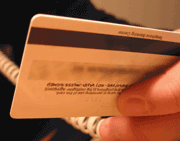Chapter 1. Magnetic stripe basics
 They are everywhere. Magnetic stripe cards are so pervasive that most sources do not even try to calculate the number of cards issued worldwide but rather simply refer to the “billions of cards.”
They are everywhere. Magnetic stripe cards are so pervasive that most sources do not even try to calculate the number of cards issued worldwide but rather simply refer to the “billions of cards.”
According to AIMGlobal, an ID technology industry association, magnetic stripe cards were first used in the early 1960’s by the London Transit Authority. The cards were used for electronic ticketing for riders of the London Underground.
The technology migrated to the U.S. in the late 1960’s when San Francisco’s Bay Area Rapid Transit began using a paper-based ticket with mag stripe for transit riders. The use of the plastic magnetic stripe card for financial purposes began in the 1970’s as credit cards embraced the technology.
What is a magnetic stripe?
A magnetic stripe is a data storage medium. It enables information to be written to it and read from it electronically. But the magnetic stripe is not the only incarnation of magnetic storage technology. The same principles are used on magnetic tapes including both audio and video cassettes as well as in floppy discs used for computer data storage. If you think about it, an audio or video tape is very much like an extremely long magnetic stripe rolled up and stored inside a plastic case.
If you have ever played with a magnet, you know that some metals are ‘magnetic’ and some are not. For example, paper clips are most often magnetic while pennies, nickels, and dimes are not. If you take tiny particles of a ‘magnetic’ metal and mix them together with a resin that acts as a bonding agent, you create a magnetic paint of sorts. Apply this paint to a substrate such as paper, film, or plastic and you have made a magnetic medium–a stripe, a card, a cassette tape, etc.–capable of storing data. Most magnetic stripes utilize either barium ferrite or iron oxide (also called gamma ferric oxide) as the magnetic particles in the stripe.
How do these magnetic media store data?
Magnetic media store data via a technique called magnetic encoding. A good way to think of this process is by picturing the creation of a child’s toy magnet. The magnet is formed using a mix of metallic particles and bonding particles. It is not automatically magnetic, however, because the billions of individual particles are pointed in all directions. Each exerts its own mini-magnetic pull but the chaotic directions of the pulls negate the overall force. By placing the newly formed magnet between two extremely powerful existing magnets, the particles in the new magnet are aligned in a single direction. The forces of the existing magnets align the billions of chaotic particles. It is this common alignment that orients the pull of all the particles in the same direction forming the magnet’s ability to attract other objects.
It is key to the success of the child’s magnet that the particles, once aligned, hold their alignment rather than reversing back to a state of chaos.
For a magnetic stripe, the same principle is used but in a very finite and precise manner. The particles in the magnetic stripe are aligned in specific directions to represent data. The encoder applies a magnetic force to a specific area of particles orienting them in a desired direction much like the strong magnets oriented the direction of the particles in the child’s toy magnet. But by making the direction of the particles change direction as the encoder progresses down the magnetic stripe (from positive to negative and negative to positive polarity), information can be represented.
It is the change between positive and negative states that indicates the information. These changes are called flux reversals (not to be confused with the Flux Capacitor that Doc used to power his time machine in the Back to the Future movies). The encoder applies opposite magnetic forces to specific areas of the stripe to record information on it and the reader monitors the stripe for flux reversals to access the encoded information.
A discussion of coercivity
Coercivity defines the level of magnetic force required to affect or alter the information encoded on a magnetic medium. Magnetic stripe cards are categorized as either low coercivity (LoCo) or high coercivity (HiCo). As the names suggest, a LoCo stripe requires a lower level of magnetic force to alter its encoding than does a HiCo stripe.
Magnetic force is measured in units called oersteds. Coercivity, therefore, is a function of the oersted level. As defined in ISO/IEC 7811, a LoCo stripe is generally considered to have a coercivity level of 300 oersteds. The commonly used level for a HiCo stripe ranges from 700 – 4200 oersteds though more frequently a range of 2500 – 4000 oersteds is now utilized.
Why is coercivity important? It is a major factor in the magnetic stripe’s lifespan and tolerance to accidental erasure. Items such as refrigerator magnets, children’s toys, stereo speakers, purse and wallet clasps as well as a host of other everyday items contain magnets. A magnetic stripe, brought into close proximity to a magnet, can be damaged. But while these common magnets can impact a LoCo stripe, it is unlikely that they possess the magnetic force sufficient to damage a HiCo stripe.



